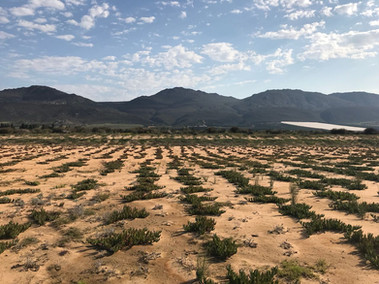Sourfigs, the OG of veldkos
- ElzanneSingels
- Feb 18, 2022
- 4 min read
Updated: Feb 4

If you have been in the Cape Floristic Region you know it is crispy this time of year. We are in the middle of our gruelling summer, which is dry, hot and prone to wild fires. During this time many plants decide to go into dormant phases to survive. Their leaves either wither away and fall off completely, or they simply become dry and crispy and wait the heat out. During this time it might have been quite tricky for hunter-gatherers to find their recommended daily allowance of greens, as most of everything that was edible is shrivelled and brown.

There are however, a few plants that have clever adaptations to flower, fruit and flourish during this time, and they avoid the mad rush to catch the eye of would be pollinators and seed distributors by flowering during a time when not much else can.
Enter Sourfigs!

Sourfigs have been eaten by hunter-gatherers in the Cape Floristic Region for thousands of years.
I found the evidence of them being foraged in the archaeological record during my PhD, when I looked at the plant remains from rock shelters all over the Cape Floristic Region. I found sourvig fruit parts in multiple sites dating back as far as 8000 years ago.
The one example (left) is particularly amazing as it clearly illustrates how the fruit was enjoyed. This is just the top of the fruit, which acts almost like a little handle which is pinched, then the bottom of the fruit is bitten off and eaten. You can see clearly, where the fruit was bitten off by a hunter-gatherer thousands of years ago!!
These formidable succulents are super, uber hardy and can grow, flower and fruit during summer. These plants form mats of creeping arms that can span many many square meters. They are so hardy that they are used to stabilise dunes, and have been used for this purpose all over the world.
Above an example of stabilisation of a sand mine during the peak of summer, with the use of sourfigs.
Unfortunately, because they are so tough and functionally useful they have become invasive in many Mediterranean countries, USA, Australia etc. But! Today I am going to share two recipes you can use to eat the problem away (if you are in these areas). For us locals in the Cape Floristic Region where sourfigs are endemic, sourfigs are one of the few indigenous plants that you would really struggle to make a dent in by foraging, so even here you can harvest them in the appropriate spots. Better yet, plant them in your garden and prune them back by harvesting them.

On a recent trip to the Cederberg I had the opportunity to harvest a particularly ripe and sweet batch from a friends garden. Sourfigs get their name for their super tart, and tannin filled taste (they dry out your mouth completely!) The art of finding the perfect sourfig I am still perfecting. To eat a sourfig as hunter-gatherers did (and it be a pleasant experience), you have to find the absolute ripest and sweetest fruits. In my experience, the hotter the place gets where you are harvesting them the better. I usually look out for the red and orange hues in the fruit that also signal that they will be sweet. At this stage the fruit starts to go a little soft, and smells of very ripe golden delicious apples.
The fruit consists of the bottom pyramid (the ovary) where the sweet, seed filled syrup is that is traditionally sucked out. In my experience, if you get a ripe enough sourfig you can eat the flesh of this part aswell. But I have been told that I have a very high tolerance for tannins, probably from my years of trying to eat uber bitter corms for my research. My tastebuds must be fried.
The top fingers of the fruit are also edible, but I reserve them for pickles and ferments. In fact, all part of sourfigs are edible, but just very sour! I usually give them a quick wash after harvesting and use them as quickly as possible.

I decided to make a Sourfig beer and add the fingers to an existing seaweed saurkraut. They both turned out absolutely divine!
I am honestly astounded by how sophisticated the taste turned out of the beer, for a wild yeast! The fruits must be covered in very good yeast.

Sourfig beer!
You will need
2kg Fresh Sourfigs
2 Pineapples
2 cups of sugar
15 litres of water
Sterilised fermentation vessel with an air valve
Sterilised bottles
Method
Slice sourfigs into slices, reserve the finger tips for pickle/ferment
Slice pineapples into chunks, add the skins too!
Add all the ingredients to you fermentation vessel and stir until the sugar is dissolved.
Leave to ferment for at least a week,
Bottle and allow for a second fermenation for about a week. This will give it fizz!

Sourfig kraut
You will need
Sourfig leaves cut into slices
Cabbage of your choice (same weight as sourfig)
Salt (1.5% of weight of other ingredients)
Fenugreek seeds
Method
Cut all ingredients finely, smush them together and bottle in a sterilised bottle! Leave to ferment for a week or two and enjoy!
Now for the picture perfect finales of the resulting products!!
Sourfig beer:





Sourfig Kraut



Happy fermenting!























Comments